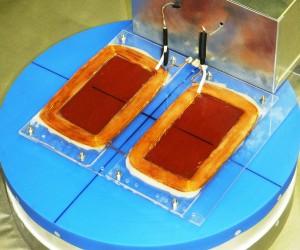
A prototype of the world’s first NMR scanner to precisely measure the level of marbling in cattle is seen in this photo provided by the National Institute of Advanced Industrial Science and Technology
The National Institute of Advanced Industrial Science and Technology said it has developed the world’s first proton nuclear magnetic resonance (NMR) scanner to measure the amount of marbling in live beef cattle. The scanner sends radio wave signals to the bodies of the live animals and quantify the level of marbling in about 10 seconds based on water and fat content. The scanner enables better evaluation of beef cattle pricing by presenting objective data to describe their meat quality, and can also be used to diagnose diseases in cattle, the institute said. The device, which was created by using an NMR scanner used to scan concrete buildings without destroying them, sends radio wave signals to the area between the skin and flesh 3cm deep, lets it cause resonance and measures the relaxation time, the time needed to finish resonating.
Muscles generally have a shorter relaxation time while fat has a longer relaxation time. By measuring the amount of the two components and analyzing fat molecules in fat tissues and water molecules in muscle tissues using computers, researchers managed to determine marbling scores in cattle.
Since it takes only about 10 seconds for the device to determine the level of marbling, cattle don’t have to be put under sedation to be kept still. The device can also be used to diagnose such diseases as myositis, and to determine the amount of marbling in other premium food products such as branded pork and tuna.
Currently, ultrasonic diagnostic imaging system is used to measure the grade of marbling, which is a major element in deciding cattle prices at auctions. After the bodies of cattle are scanned, experienced experts need to look at the images to evaluate the level of marbling, because it is not presented in terms of numerical data.
The institute has been conducting research on the new device since 2005 with the aim of developing the technology of measuring the level of marbling in live cattle in a short time. If the device is commercialized, it will become available at a price of roughly JPY30 million, according to the institute.
“We plan to present the results at a meeting of the Japanese Society of Animal Science in September and we hope some measuring equipment manufacturers will be willing to commercialize the technology,” said Yoshito Nakashima, chief senior researcher at the institute.
(July 9, 2015)

